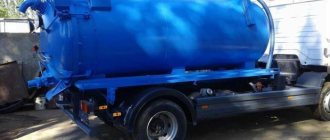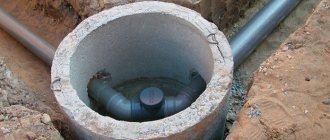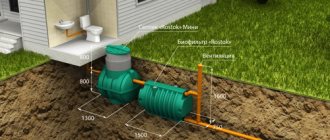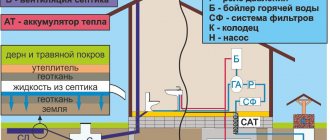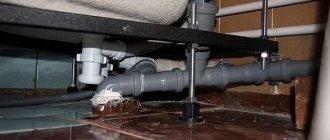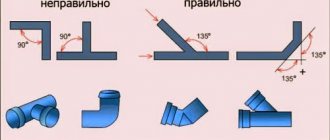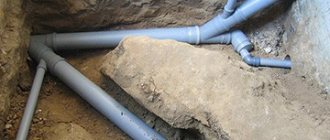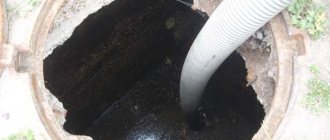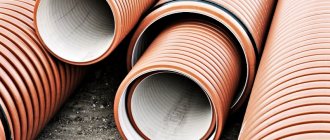Every resident of a country house wants to use clean water not only for food, but also for household needs.
And in the process of human economic activity, environmental pollution, septic tanks and sewer overflow occur. Therefore, periodic pumping of sewerage in a private house is not only inevitable, but also extremely necessary.
Its pumping may not be necessary if the sewerage system is connected to the city system, but in our conditions for a private country house this is very rare.
Methods for pumping out sewerage in a private house
Let us clarify that we will be talking about the sewerage of household wastewater, without confusing the problem of removing storm flows.
If the second task is related only to the fight against excessive waterlogging of the soil on the site, then the supply of high-quality water and the creation of conditions for a healthy lifestyle depends on the solution of the first.
These wastewaters are usually saturated with various bacteria and chemical contaminants. They can poison clean groundwater sources.
Country toilet
You should start with how to clean the toilet in the country. There is not much choice here, since such structures are not very conveniently located, so access to them for a sewer truck is sometimes difficult. Of course, this option is the most convenient and simplest, because it’s easy to call specialists. But, if the settlement is located far from the city, this may be a problem, and such services will be expensive.
Cleaning a country toilet can also be done in other ways, among the most popular:
- Chemical reagents. These are substances that transform fecal matter. Due to their influence, fecal masses decrease in volume, their consistency changes, and the smell disappears or decreases. After this, they are not difficult to remove mechanically. Chemicals can be used at any time of the year and this does not reduce their effectiveness. The problem and significant drawback is that they are not safe for the environment; it is important to strictly follow the instructions for use and dosage.
- Biological substances. The products are much more expensive, but the cesspool will be cleaned safely. Wastewater recycling is also very efficient; the period depends on the type of product chosen and the volume of the cesspool. As a result of processing, a liquid is obtained that is partially absorbed into the walls and bottom; the remainder can be pumped out without any problems.
- Mechanical cleaning. Everything here is clear and one might even say simple, but quite unpleasant. Feces must literally be scooped out of the hole and dumped somewhere else. Some owners recommend using a garden auger to make holes in the area and drain the masses there. Afterwards, sprinkle with earth, a layer of 10-15 cm, after it all rots, the earth will become fertilized with high-quality compost.
Bacteria and chemicals are easy to use - you just need to pour them into a cesspool and wait for the reaction to occur. In some cases, biological substances must first be diluted with water.
Important! There is also a radical method - this is to bury an old hole and dig a new one, placing a wooden toilet booth over it.
Cesspool cleaning products
Application of biologically active substances - chemical sewage pumping
The contents of septic tanks are also neutralized using chemicals. Their action is based on the neutralization of biologically active substances and the oxidation of feces.
As a result of this impact, most of the wastewater turns into a liquid-flowing state, penetrates more easily through the soil and is filtered in it. As a result of this treatment, the need to pump out sewerage in a private house occurs much less frequently.
As a result of using biochemical treatment methods, the need for pumping may not occur at all. This is possible in the following cases:
- the septic tank is installed on a country plot with periodic visits;
- the cesspool is used only for fecal waste; stormwater and household waste are discharged separately;
- the pit must have a significant volume and transverse dimensions so that the wastewater has time to filter into the ground.
If such conditions are not met, biochemical methods can only increase the frequency of pumping, but it will not be possible to completely abandon it.
Strictly speaking, treatment with biochemical materials is not pumping. Simply processing changes the physical state of the wastewater, its consistency. At the same time, the resulting mass acquires many useful qualities as a fertilizer and is successfully used in gardening and horticulture.
Modern models of septic tanks also use wastewater aeration by blowing with air flow. The increased concentration of oxygen in the liquid flow leads to accelerated oxidation of decay products in the fecal mass and contributes to its faster purification.
This process is called aeration and involves the use of an air compressor.
When is it time to cleanse?
Cleaning cesspools, regardless of the method chosen, is an unpleasant process, but it still needs to be done from time to time.
Important! Cleaning is simply necessary, because if the level of wastewater exceeds the permissible level, and everything that is in it comes to the surface, there is a risk of severe soil contamination.
Factors that indicate that the time has come:
- The drains are visible to the naked eye 10-15 cm below the upper level of the cesspool. If this concerns a country cesspool, then it is better to clean it when it is 2/3 full of the total volume.
- A strong unpleasant odor appears - this indicates that the waste is beginning to rot and no longer goes into the soil.
- The water in the sink, shower, and toilet drains much more slowly.
The same criteria apply to the country toilet; experts recommend completely emptying it at the end of each season, there are many reasons for this, including:
- The risk of bacterial growth that is harmful to both humans and the environment.
- Formation of toxic gases in case of long-term stagnation of fecal matter. They have a toxic effect on living organisms.
- Risk of toxins entering the soil, leading to plant death.
- The accumulation of odors and the fight against them will become increasingly difficult.
An old-fashioned way to empty a cesspool
This method of emptying a cesspool involves scooping out its contents with a bucket on a rope or pole. The work is slow, dirty and smelly.
In addition, it makes sense to carry it out only if there is a waste disposal site nearby. In addition, you will need a closed container to transport the pumped out contents of the septic tank.
Cleaning not possible: alternative
There are situations when cleaning an earthen toilet pit is either difficult or even impossible (the old structure is dilapidated and threatens to collapse). In this case, a more correct solution would be to dismantle the building, fill the cesspool and move the toilet to a new location. The best materials for backfilling are a mixture of peat, sawdust and earth. The use of sand, construction waste, broken bricks, ash, etc. will make this area unsuitable for gardening work.
If the building is dilapidated, it is worth changing the force of habit and moving the toilet to a new place
If possible, the pit should be pre-treated with a bioactivator, then a layer of a mixture of bulk materials should be laid. Lay bundles of reeds, bush branches or garden tree trimmings on it, then again a layer of bulk materials. This will prevent the danger of falling into an old hole. In a few years, it will be possible to grow cultivated plants in the place of the cesspool.
Pumping using pumps of various modifications. Pumping algorithm
The second method is to use a pump. Various types of units can be used.
- You can pump out sewerage in a private house with a surface pump, which is installed outside, directly next to the septic tank or cesspool. Only the intake hose is immersed in the container. Solid fractions in the pumped-out mass should not be larger than 5 millimeters, so a filter mesh with a mesh of the appropriate size is installed on the intake hose. The positive qualities of surface pumps include such features as mobility, light weight and ease of installation, the presence of a grinder and air cooling.
- The pump is semi-submersible, in which the motor is located above the drainage level (on the platform), and the pump itself is inside the liquid layer. Equipped with a float switch. The maximum size of solid inclusions is 50 millimeters.
- You can pump out sewerage in a private house using a submersible pump; despite the noticeably higher cost, they are the most popular for this purpose. Such units reach a power of up to 40 kW and a lifting height of 40 meters, are equipped with choppers and float switching devices, which allows them to be used in automatic mode.
Such units are also equipped with grinders, which allows them to be used for working with heavily contaminated liquids with large inclusion sizes.
The possibility of safe operation of the device is ensured by an automatic liquid level control.
Do-it-yourself sewer pumping - preparatory work
This operation is necessary, first of all, to ensure the functionality of the device itself. Delay in such work can lead to the accumulation of silt, which over time hardens into heavy, hard clay.
Watch the video
Sewage without pumping after a year.
Such a substance can only be removed mechanically and the labor intensity of such work is very high.
Under normal conditions, after pumping out the bulk of the liquid, the sludge can be washed away with a jet of water under pressure and the resulting slurry can be pumped out with a mud or fecal pump. After this, the sewerage pipelines are inspected and, if necessary, flushed or mechanically cleaned.
When planning to tidy up your wastewater system, you need to take care of the following issues:
- It is necessary to determine in advance where waste will be stored for removal.
- Prepare a container of the required volume for pumping out the contents of the septic tank. In this case, it is necessary to take into account that, in addition to itself, it will be necessary to pump out the flushing water after washing away the sludge and cleaning the sewer pipes. The container for pumping out sewerage must be hermetically sealed so that during transportation the liquid does not splash out along the way.
- Decide on equipment for pumping - select and purchase a pump, as well as auxiliary equipment and devices for cleaning pipes. Please note that you may not have to purchase a pump; it can be rented at a daily rate for the duration of the work.
- Pumping out the contents of a septic tank is associated with the formation of unpleasant odors, sometimes very strong (you can make a sewer without pumping at all). Therefore, it is better to send family members living in the house somewhere far away.
Step-by-step do-it-yourself pumping process
We have already discussed pumping equipment that can be used for this purpose.
The choice depends on the texture of the pumped product and many other factors, including the distance of the septic tank from the entrance - the pump must have sufficient pressure to pump the thick substance over a long distance.
Additional opportunities for pumping out are provided by the presence of a device such as a chopper. The more often the septic tank is cleaned, the easier and faster this operation occurs.
After pumping out the bulk of the sewage, the bottom of the septic tank is washed out and mechanically cleaned of silt deposits. They are mixed into one pile and shoveled into a bucket. Then rinse again and pump out the washing liquid.
Watch the video
Next, you need to inspect the drain pipe; its internal clearance is often significantly reduced due to contaminants adhering to the walls. To remove them, various means are used, including special hydrodynamic devices.
How much does the pumping service cost?
Let’s now figure out how much this service can cost. If a sludge pumping service in the Moscow region costs about 12,000 rubles, then the use of vacuum equipment will cost about 18,000. In addition, the remoteness of the site also matters - outside the Moscow ring road, each kilometer run will cost 30-50 rubles.
Frequency of sewer pumping in a private house
One way or another, septic tanks need to be cleared of their contents from time to time. The frequency of such an event depends on several factors:
- Storage tank volume. The smaller it is, the more often cleaning is needed. In accordance with the requirements of SanPiN, a cesspool or septic tank must be cleaned at least once every six months, but large tanks can be cleaned less often. The requirement is valid for a family of 3 - 4 people. Mandatory cleaning is carried out when the filling level of the septic tank reaches 75% of the maximum.
- Frequency of use of the sewer system, depending on the number of users.
- Material used to form the drainage system. This refers to its filtering capacity. As the sludge layer accumulates, the throughput of any filtrate decreases.
- A variety of bacteria used for wastewater treatment - anaerobic and aerobic. The use of such material and processing method increases the speed of wastewater treatment tens of times.
- Aeration of wastewater to accelerate oxidation processes.
The use of bacteria for processing sewer drains, in addition to speeding up the process, increases the fluidity of the substance, due to which the process of its filtration occurs - the article contains detailed information about bacteria for septic tanks and cesspools.
Of course, complete wastewater treatment is impossible; using a local treatment system can achieve a result of a 98% degree of purification. You can safely water your garden, wash your car, or use it for other technical purposes with this water. Naturally, such cleaning comes at a cost, since it uses electric pumps.
However, there is no installation in the world yet that can operate without periodic cleaning. Even the most advanced treatment stations must be periodically desludged.
Watch the video
The frequency of such an event, depending on the intensity of operation, is 3-7 years and consists mainly of removing sludge from the bottom and walls of septic tanks.
It should be noted that sludge from a septic tank is an excellent fertilizer for the garden. To remove plaque from the walls of pipes of treatment systems, various mechanical or hydromechanical cleaning equipment is used.
In terms of labor intensity, cleaning a septic tank cannot be compared with cleaning a cesspool.
Materials used in the production of fecal pumps
The body of the device and internal elements must be made of strong, durable materials, since fecal pumps are often designed to operate in fairly aggressive environments. Stainless steel is considered the best option; it provides a significant pump life, but the cost of such products is high.
Stainless steel pump
Various types of durable plastic can slightly reduce the price of pumping equipment, while they are inferior to other units in strength and performance characteristics. Cast iron pumps are considered strong and durable; their main drawback is their significant weight, which complicates installation.
Septic tanks and their types
A septic tank is a local treatment system that is installed in the absence of a central main line. Usually installed in country and cottage villages, rural areas remote from centralized utilities, private households significantly removed from the central sewer system.
The body is a solid-cast hollow cylinder with legs. Installed on a concrete base equipped in a pit. The multi-chamber container is divided by partitions connected to each other by an overflow system.
This design ensures gradual settling and biological clarification of wastewater. After purification, water can be discharged into the soil, if it is sandy or sandy loam, or into various containers:
- bottomless concrete wells;
- filtration fields;
- filtration blocks or wells.
Septic tanks can be aerobic, anaerobic, mixed, or biological stations. When installing, it is important to ensure an angle of inclination, since the liquid flows by gravity, and also to insulate the system from above. This will preserve the life of anaerobic microorganisms, thanks to which the biological processing of wastewater occurs.
All septic tanks, factory-made or made independently, differ:
- by container type:
- by installation method:
- manufacturing materials.
Advantages of ordering a sewer truck from Lex Ecology
The Lex Ecology company specializes in the rental of toilet cabins, their maintenance and the provision of vacuum cleaner services. We work with both large companies and individuals and are one of the leading companies in this market.
- More than 1500 dry closets monthly.
We rent out that much with regular maintenance, from once to several times a month. - Your own fleet of special equipment.
Modern vehicles with tanks of 4 and 10 m3, fully complying with the requirements of SanPiN 2.1.7.1322-03. And professional drivers - operators. - We fulfill all obligations.
Before starting work, we conclude a contract and strictly comply with all contractual obligations specified in it. This is confirmed by the gratitude we receive from our regular customers. - We are officially working.
The Lex Ecology company has all the necessary documents to carry out activities for the collection, transportation, processing, disposal, neutralization and disposal of hazard class IV waste.
Choose professionals in your field! Call us by phone
, or send a request via the feedback form at the bottom of the page. Our managers will advise you on all issues and help you choose the optimal solution specifically for your situation.
